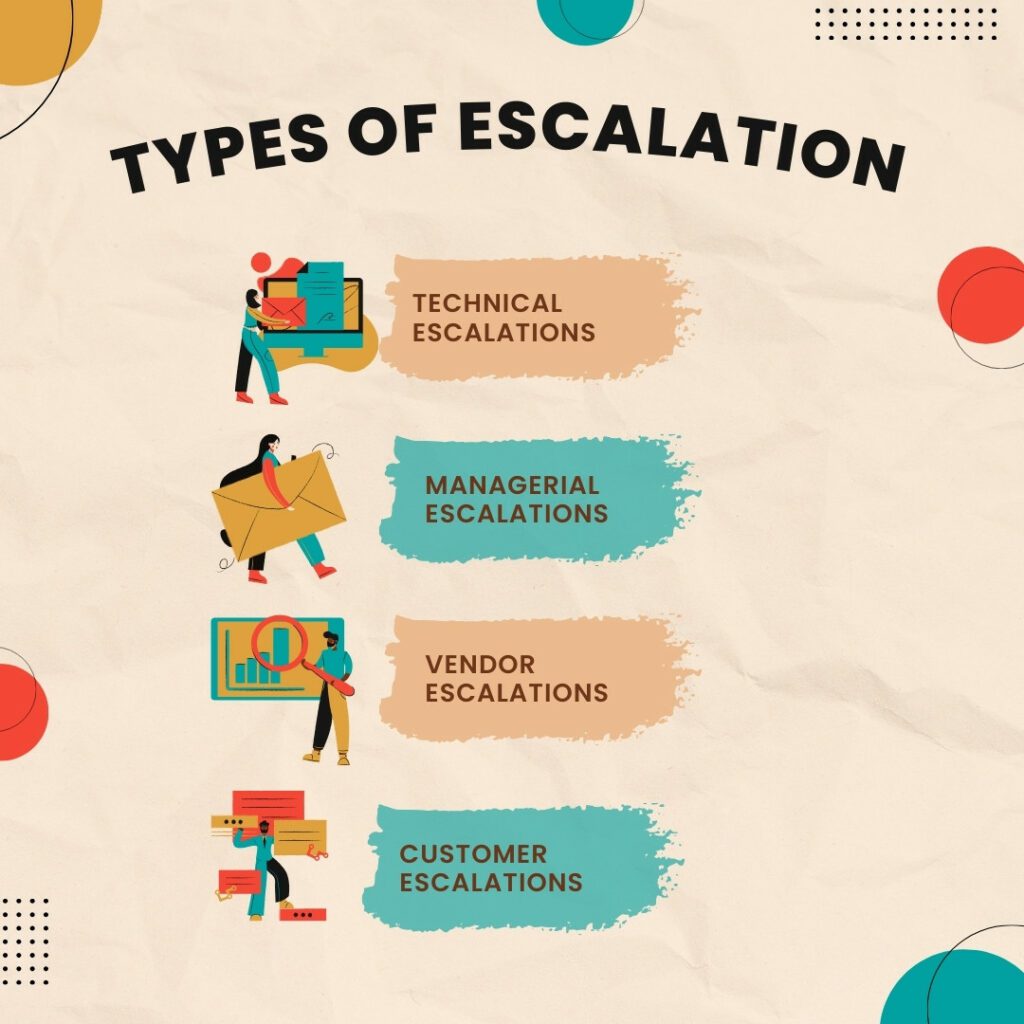Best Practices in Escalation Management
14 Nov 2023 By: Michael Kansky
Updated
Managing escalations is key to keeping the customer support team happy in any business. This article is all about solving problems fast to show our customers we hear them and care. We’ll explore why handling issues the right way is crucial, look at different methods, break down how it all works, point out the good stuff that comes from it, share some smart tips for doing it better, and talk about how using automation can make things smoother.

What is Escalation Management?
Managing escalations is a vital part of the overall customer experience, focusing on quickly solving tough problems that can’t be fixed by the usual support routes. It’s all about having a clear plan to get customer complaints or worries to the right team or people who have the know-how and power to fix them.
If a customer runs into trouble and our initial team can’t solve it, that’s our signal to escalate. We’re talking about stimulating up the support, adding a personal touch, and making sure we tackle their problem swiftly and with finesse.
Good escalation management framework starts with clear rules on how to sort out problems. By figuring out what category an issue falls into, support teams can decide how much effort and resources to put into fixing it. This way, the big problems get dealt with first and fast, stopping any extra hassle for the customer.
Quick response in managing escalations is fundamental. Organizations must establish definitive service level agreements (SLAs) to ensure prompt attention to escalated issues. This strategy not only demonstrates to customers that their issues are taken seriously but also aligns expectations on resolution timelines. Implementing clear SLAs facilitates effective communication between the company and its customers, fostering a sense of reliability and trust. Ultimately, this approach helps maintain customer satisfaction by ensuring they know when their concerns will be addressed.
Effective customer escalation management boosts customer loyalty. Swiftly addressing concerns builds trust, enhancing satisfaction and loyalty. Happy customers often return and recommend the business, attracting new clients. In essence, a solid escalation plan not only resolves issues quickly but also fosters long-term customer loyalty by ensuring satisfaction.
Types of Escalations
When issues arise with our partners, such as late deliveries, unexpected products, or poor customer service, we need to escalate matters. This may involve discussing the issues with their higher-ups or involving our specialists who manage these relationships.
Escalations can manifest in various forms, depending on the complexity and severity of the issue. Some common types of escalations include:
- Technical Escalations: When issues require specialized technical knowledge or expertise.
- Managerial Escalations: When customer concerns require higher-level intervention beyond front-line support.
- Vendor Escalations: Now and then, things don’t go smoothly with the companies we work with or get supplies from.
- Customer Escalations: And then there are times when our customers really aren’t pleased because we haven’t fixed their issues just yet.

When tech troubles get too tough, they’re passed on to someone with the expert skills to untangle them. If the initial team hits a wall with a complicated issue, they pass the baton to a tech guru to crack it.
If a customer’s issue isn’t resolved by the first team, managers or supervisors step in with the authority to make significant decisions and ensure quick, effective solutions. Similarly, when facing problems with partner companies, such as late deliveries or poor service, escalating the issue to their higher-ups or involving our relationship experts is crucial. This approach maintains smooth operations and strong partnerships, focusing on swift, satisfactory resolutions for all involved.
When issues with partners arise, such as late deliveries or poor service, it’s essential to escalate by consulting their higher-ups or involving our relationship specialists, ensuring smooth operations and strong relations. Understanding the escalation process allows businesses to develop a clear action plan for identifying, addressing, and swiftly resolving problems, empowering team members to effectively satisfy customers and maintain seamless operations.
How to Operate Escalation Management Effectively
An effective escalation management process includes key steps to fix problems smoothly:
1. Identification: Spot when issues need extra attention with clear rules.
2. Documentation: Keep a detailed record of the problem, communications, and actions taken.
3. Assessment: Figure out how big and complex the issue is to get the right help.
4. Communication: Tell the right people about the issue and keep them in the loop.
5. Resolution: Act fast and smart to solve the problem.
6. Follow-up: After solving it, get feedback and make changes to avoid the same issues later.
This approach helps avoid confusion, solves problems faster, and keeps customers happy.

Benefits of Proper Escalation
A good escalation management process brings many perks:
- Happier Customers: Fixes problems quickly and well.
- Better Brand Image: Solves issues efficiently, showing you care.
- Fewer Lost Customers: Careful handling keeps people from leaving.
- Empowered Employees: Staff feel responsible and capable.
- Spot and Stop Repeat Issues: Finds and fixes underlying problems before they happen again.
Investing in a solid escalation plan pays off by making customers and employees happier.
Trending now
Social media, now essential for customer service, requires fast, strategic responses to prevent issues from escalating. Brands struggle with high message volumes, risking overlooked concerns and customer dissatisfaction. Effective escalation management, categorizing issues by severity for proper handling, is crucial for timely responses and customer retention. This strategy ensures digital customer service remains proactive and organized, essential in today’s digital-first customer interaction landscape.
Escalation management streamlines handling customer support by directing issues to the right team members. It differentiates between functional (specialized knowledge needed) and hierarchical (higher authority required) escalations. Key strategies include establishing clear service-level agreements, boosting self-service, providing associates with the right skills and tools, setting explicit escalation paths, avoiding quick escalations, and reviewing escalated tickets for improvements. These practices ensure efficient problem resolution and improve customer satisfaction.
Key Strategies for Effective Escalation Management
To ensure effective escalation management, organizations can adopt the following strategies:
- Clear Rules: Make and share guidelines on when and how to escalate issues. Ensure everyone knows what to do.
- Training and Power: Teach frontline staff to solve problems and let them make decisions to prevent unneeded escalations.
- Track Escalations: Use a central system to keep an eye on escalations, making things clear and accountable.
- Keep Talking: Make sure to keep customers and everyone involved in the loop about what’s going on with their concerns.
- Work Together: Rally the teams to chat and collaborate in solving those tougher issues that need an extra push.
Putting these strategies into action can make escalation handling more effective and efficient.
Strategies for De-escalating Escalations
De-escalating escalations is an essential skill, enabling organizations to defuse tense situations and restore confidence in customer interactions. Some strategies to de-escalate escalated issues include:
- Listen Well: Hear out customers’ worries with empathy.
- Apologize: Apologize sincerely for any trouble caused.
- Take ownership: Assure them you’re on their side and committed to sorting things out.
- Offer alternatives or solutions: Show you’re eager to solve the problem by offering solutions.
- Follow Up: Make sure the issue is resolved and check back to see if the customer is happy.
Using these methods helps fix problems and rebuilds trust.
Measuring Escalation Performance
Keeping an eye on how well we handle escalations is key to making things better over time. Here are some simple ways we can measure our success:
- Time to Fix: We track how long it takes to sort out an issue once it’s been escalated.
- Success Rate: We look at what percentage of escalated problems we’re able to resolve quickly.
- Customer Happiness: We ask our customers how they felt about our help in fixing their issues.
- Repeat Issues: We keep an eye out for problems that keep popping up, which might mean there’s a bigger issue at play.
By regularly checking these areas, we can spot patterns, figure out where we’re slowing down, and find ways to improve our escalation process.
Utilizing Automation for Escalation Management
Automation can really help smooth out and improve how we handle escalations, making everything run more efficiently. By leveraging technology, organizations can:
- Smart Routing: Set up smart systems that automatically send tough cases to the right people based on set rules.
- Instant Alerts: Use alerts to keep everyone updated on what’s happening with a problem, step by step.
- Integrate communication channels: Enable seamless collaboration across different communication channels, consolidating all relevant information and conversations in one platform.
- Data Insights: Use tools to look at data, spot trends, repeat problems, and chances to make things better.
These steps streamline managing tough cases, improving the support experience. Automation, real-time updates, unified communication, and data analysis make problem-solving more efficient and customer service better. This approach ensures customers feel valued and support teams work effectively.
Conclusion
Dealing with escalated issues is a big part of making sure customers stay happy. When businesses use perfect strategies, they can sort out problems fast and well, which makes customers feel valued and boosts the business’s image. Getting this right means having a clear plan everyone understands, teaching the team how to handle these situations, keeping an eye on how things are going, and using tech to help out. Continuously making things better shows customers that a business cares, helping it shine as a place known for amazing service.
At HelpSquad, we specialize in handling escalations with precision and care, ensuring that customer issues are resolved quickly and effectively. Our expert BPO services are designed to support your business by offering round-the-clock assistance, empowering teams, and utilizing the latest technology to streamline your customer service operations. Ready to elevate your support strategy and keep your customers satisfied? Explore HelpSquad’s top-tier BPO solutions here and discover how we can make a difference.


